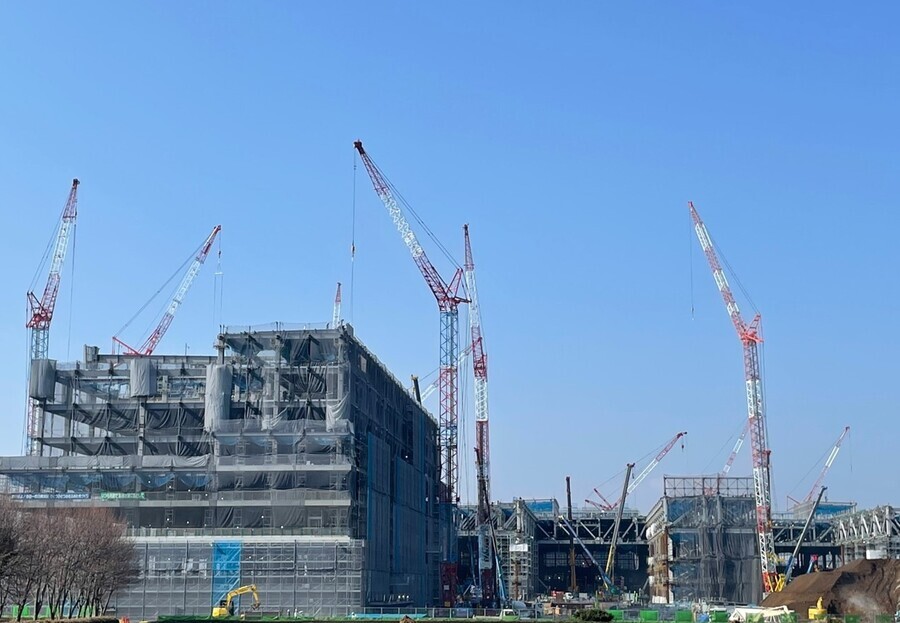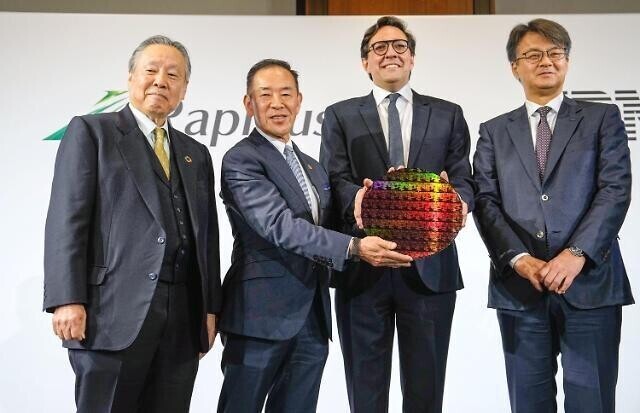hankyoreh
Links to other country sites 다른 나라 사이트 링크
[Reportage] After 30 years of stagnancy, Japan aims to revive its role as chip powerhouse

“You mean the TSMC construction site? Sure, I can take you there.”
This was what a taxi driver told me after I approached him upon landing at Aso Kumamoto Airport in Kyushu, Japan, on Feb. 8 after a two-hour flight from Tokyo.
He shifted into gear and went down the roads as if the route was familiar to him. “People come from all around to see it, so I know the way well,” he said. After about 15 minutes, a massive construction site appeared between the cabbage fields.
The site, which was surrounded by a temporary 2-meter-high wall, was full of dozens of cranes, excavators, and large trucks which were all hectically busy.
This is the first semiconductor plant being built in Japan by Taiwan Semiconductor Manufacturing Co., or TSMC, the world’s largest chip foundry. The total site is huge, measuring about 210,000 square meters (2.2 million sq ft) or approximately the size of 4.5 Tokyo Domes.
Of the total 1.1 trillion yen (US$8.2 billion) the project costs, the Japanese government is subsidizing 476 billion yen, or about 40%. This level of support for a foreign company in Japan is truly unprecedented and has not been seen in the past.
I was able to see how construction of the fab (semiconductor manufacturing facilities) and office buildings were taking shape.
Construction of the plant started last spring and is scheduled to be completed by this December. The goal is to have the first semiconductors made there shipping by next December.
The site is being constructed and operated by JASM, a subsidiary of TSMC in which Sony and Denso, an automobile parts maker, also have stakes.
On the other side of the construction site, about 5 minutes away, is a Sony Semiconductor Solutions plant.
About 10 minutes further is a plant belonging to Tokyo Electron Kyushu, a global semiconductor equipment company. Seeing it for myself, I got the sense that the whole area would become the new hub for the Japanese semiconductor industry once construction of the TSMC plant is completed.
In fact, Japan was known as the “absolute powerhouse” in the global chip market from the mid-’80s till the early ’90s. The country is now dreaming of a major revival of this industry to break out of the 30 years of stagnation it has experienced.
Semiconductors, often called the “rice” of industry due to their ubiquity in a range of appliances, are a key future industry with global sales expected to double by 2030 to approximately 120 trillion yen.
Well aware of these facts, the Japanese government has singled out the semiconductor industry as a national strategic industry and is providing large-scale support so that semiconductor production can be done domestically.
Japan is also actively responding to confusion that has shaken the entire market, such as supply chain reorganization and technological competition in the semiconductor industry, which was spearheaded by the US-China rivalry. Tokyo sees this as an opportunity for a major leap forward in developing its own domestic semiconductor prowess.
But by joining forces with semiconductor powerhouses Taiwan and the US, Japan is also turning up the pressure on South Korea.
The TSMC semiconductor plant in Kumamoto is the biggest symbol of Japan’s endeavor to revive its semiconductor industry. It plans to produce 55,000 semiconductors (300-mm wafer equivalent) with circuit line widths in the range of 10 nanometers to 20 nanometers each month.
Although these are not the sub-10-nanometer semiconductors that currently are the cutting edge of technology, the plant will enable the production of enough semiconductors to meet domestic demand in Japan.
Until now, the 40-nanometer chips manufactured by Renesas Electronics have been the best performing semiconductors produced in Japan.

Meanwhile, the city of Kumamoto is also excited about what this new plant could bring.
“Efforts to recover from the April 2016 Kumamoto earthquakes have continued in the region. The introduction of this plant signals a regional revival,” says Hideo Urushima, head researcher at the Kumamoto Industrial Research Institute.
Expectations are also naturally high for positive economic impacts such as job creation.
“The gross production of Kumamoto Prefecture is about 6 trillion yen and the investment cost for the TSMC plant is over 1 trillion yen. There are more than 100 semiconductor-related companies in the prefecture. There are estimations that the economic ripple effects that this factory will bring to the prefecture will be 4.3 trillion yen over 10 years,” Urushima said.
Jobs related to the industry are also set to increase significantly. About 1,700 people will work in the new plant, including 320 technicians sent by TSMC in Taiwan, 200 from Sony Group, and 700 new and experienced hired workers.
Including jobs in related industries, predictions point to 7,500 new jobs being created in the prefecture. As such, recruiting top talent is emerging as a major task.
To this end, Kumamoto University created a dedicated semiconductor research and education center last April. The plan is to open a new department next year to teach semiconductor manufacturing and process management. It would mark the first new department established at the university since its founding in 1949.
“Having secured the TSMC plant is a good opportunity to develop excellent talents related to semiconductors. [Students] could learn the latest knowledge and technology while working for the world’s best company [in this field],” says Masahiro Aoyagi, director of the Kumamoto University Forefront Research and Education Center for Semiconductors.
The whole of Kyushu, which was known as “Silicon Island” in the 1980s because it accounted for 10% of world chip production, is also feeling the excitement.
Other semiconductor-related companies, such as Sony, Kyocera, Mitsubishi Electric, Tokyo Electron, and Taiyo Nippon Sanso, are also increasing their facilities or preparing to expand their own plants. Having so many related fields, including materials, parts, and equipment, is exactly why the semiconductor industry is so powerful. What’s more, TSMC is also reportedly considering building a second plant in Japan.
Meanwhile, the Japanese government is also jumping into the field of state-of-the-art semiconductors used in supercomputers and artificial intelligence (AI).
Eight of Japan’s major conglomerates, including Toyota and Nippon Telegraph and Telephone, came together last November to establish a new company called Rapidus. The name refers to the rapid production of new chips.
So far, the companies have invested 7 billion yen in the project with the Japanese government set to provide more than 70 billion yen.
IBM has also agreed to work with Rapidus not just in joint research focused on 2-nanometer node technology but also in cooperation with Rapidus scientists and engineers as well as setting up differentiated strategies in manufacturing.
Rapidus plans to begin full-scale mass production around 2027, following trial production of 2-nanometer chips in 2025.
“If the semiconductor manufacturing system in Japan weakens, it will be difficult to maintain competitiveness in materials, parts, and equipment, which are currently doing well. Continued support from the government is important for the revival of the lost semiconductor industry,” Aoyagi emphasized.
By Kim So-youn, Tokyo correspondent
Please direct questions or comments to [english@hani.co.kr]

Editorial・opinion
![[Column] Season 2 of special prosecutor probe may be coming to Korea soon [Column] Season 2 of special prosecutor probe may be coming to Korea soon](https://flexible.img.hani.co.kr/flexible/normal/500/300/imgdb/original/2024/0426/3317141030699447.jpg) [Column] Season 2 of special prosecutor probe may be coming to Korea soon
[Column] Season 2 of special prosecutor probe may be coming to Korea soon![[Column] Park Geun-hye déjà vu in Yoon Suk-yeol [Column] Park Geun-hye déjà vu in Yoon Suk-yeol](https://flexible.img.hani.co.kr/flexible/normal/500/300/imgdb/original/2024/0424/651713945113788.jpg) [Column] Park Geun-hye déjà vu in Yoon Suk-yeol
[Column] Park Geun-hye déjà vu in Yoon Suk-yeol- [Editorial] New weight of N. Korea’s nuclear threats makes dialogue all the more urgent
- [Guest essay] The real reason Korea’s new right wants to dub Rhee a founding father
- [Column] ‘Choson’: Is it time we start referring to N. Korea in its own terms?
- [Editorial] Japan’s rewriting of history with Korea has gone too far
- [Column] The president’s questionable capacity for dialogue
- [Column] Are chaebol firms just pizza pies for families to divvy up as they please?
- [Column] Has Korea, too, crossed the Rubicon on China?
- [Correspondent’s column] In Japan’s alliance with US, echoes of its past alliances with UK
Most viewed articles
- 1‘We must say no’: Seoul defense chief on Korean, USFK involvement in hypothetical Taiwan crisis
- 2After election rout, Yoon’s left with 3 choices for dealing with the opposition
- 3Why Kim Jong-un is scrapping the term ‘Day of the Sun’ and toning down fanfare for predecessors
- 4Noting shared ‘values,’ Korea hints at passport-free travel with Japan
- 5AI is catching up with humans at a ‘shocking’ rate
- 6Two factors that’ll decide if Korea’s economy keeps on its upward trend
- 7Amnesty notes ‘erosion’ of freedom of expression in Korea in annual human rights report
- 8[Editorial] Korea’s surprise Q1 growth requires objective assessment, not blind fanfare
- 9A week of protests lays bare many inherent vices of Korean health care system
- 10Yoon says collective action by doctors ‘shakes foundations of liberty and rule of law’